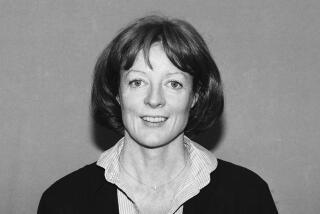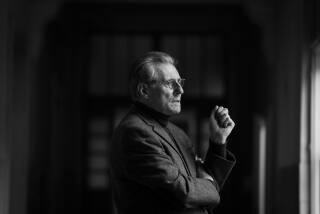The widow of ‘Downton Abbey’
When the Crawley clan of “Downton Abbey” returns to American television this weekend, I will take more than a sporting interest in the fate of the newly widowed Lady Mary. As someone who was widowed at a relatively young age myself, my fondest hope is this: that she will be no lady.
Perhaps she can help the rest of us sort out what constitutes proper behavior for a woman whose husband has died. Being a widow is one of the few female roles for which social norms still lag in a bygone era, reinforced by literature and popular culture. Widows in literature tend to fall into one of two simplistic categories. They’re either saintly sad sacks — perpetually gloomy, helpless, hopeless and dowdy, like the ineffectual Mrs. Dashwood in “Sense and Sensibility.” Or they are, like Hamlet’s mother, Queen Gertrude, glad to be unshackled, oversexed and eager to enjoy illicit freedoms.
I’m rooting for Lady Mary to bust the stereotypes. It’s about time someone emerged vital enough to break the stifling ladylike mold of widowhood yet rooted enough in reality to portray the many conflicting emotions, abundant possibilities and unexpected plot twists experienced by those of us who actually inhabit the role.
It’s a tricky line to walk. I certainly fit the sad-sack template during the months of deepest grief following my husband’s death from cancer. Still in my 40s, I knew in both my head and my heart that I was entitled to seek a full and happy life. Yet I felt bound by the persistent attitude that it is unseemly for a widow to seek new fulfillment, enter new relationships, or — hold onto your knickers — remain in possession of a still-functioning libido.
Friends suffocated me with their assumptions: “Of course, it’s too soon” when I expressed an interest in dating again, or “I assumed you wouldn’t feel up to it” when I got chopped from the e-vite list for couples’ night out. There’s a sentimental notion that someone who has lost her soulmate can never love another or is too devastated to begin again. It pervades our culture, multiplying the ambivalence survivors feel when they try to resume what for anyone else would be normal life.
I felt keenly the lack of admirable widows to emulate. Dull, proper exemplars like the Widow Douglas in “The Adventures of Huckleberry Finn” held little appeal. But a bolder widow like Scarlett O’Hara invited contempt merely for dancing at a ball. The widow played by Jennifer Lawrence in “Silver Linings Playbook” showed some gumption, but her sexual appetites were portrayed as a slutty byproduct of mental instability brought on by grief.
With a few exceptions — including the latest incarnation of Bridget Jones — a widow is rarely allowed to be a lead character. More typically, she is a helpmate on the sidelines, an object of pity, a grateful recipient of the protagonist’s generosity or, worse, an object of scorn. She’s not considered major character material because she’s pegged as someone with no desires of her own, no future, no plans for change, and therefore no potential for a heroic journey. Why would anyone waste an episode on her story?
Lady Mary’s slender aristocratic shoulders bear the potential for altering that perception. An early trailer for Season 4 shows her sunk in gloom, but there are promising hints that despite an understandable sheen of sorrow, Mary may be permitted to remain vibrant, striving, fully alive.
I’ve read that she becomes more involved in running the estate — finally, something to do! It seems that a couple of viable suitors are trolling the drawing room. And don’t forget her heedless encounter with the Turk in Season 1 — the lady has demonstrated a willingness to defy protocol before. Let’s hope that her independent, astringent personality remains intact, so she can deliver withering putdowns to those who assume she’s become a cliche.
I realize that “Downton Abbey” creator Julian Fellowes didn’t choose this path for his marquee character. The departure of actor Dan Stevens, who starred as Mary’s husband, saddled the show with the Widow Mary storyline. But in fact, the scenario offers rich possibilities for her reinvention and self-discovery, just as it does for widows in real life.
Actual widows like Katharine Graham and Katie Couric rose to new heights after losing their husbands, because, outside of fiction, few of us feel grief-stricken 24 hours a day. Most of us experience waves of normality, even scandalous flashes of humor. Over time, we benefit from new achievements and friendships, possibly even new love affairs.
In the few years after I was widowed, I left my longtime career, plunged into slapstick escapades of dating, met a man who became my second husband, moved to a new home and grappled with the complexities of becoming a new wife and rookie stepmother. My loss was tragic, wrenching. But it opened invigorating possibilities for drama and, yes, even comedy.
So here’s to Lady Mary taking up aviation, or wildlife photography, or a lover. Maybe she can demonstrate that a widow, facing an
uncertain future and a need to remake herself, need not choose between the poles of lady and tramp. Neither maudlin nor wanton, but real, a widow can be a vigorous, noble and complex heroine in art and in life.
Becky Aikman is a journalist in New York and author of the memoir “Saturday Night Widows: The Adventures of Six Friends Remaking Their Lives.”
More to Read
A cure for the common opinion
Get thought-provoking perspectives with our weekly newsletter.
You may occasionally receive promotional content from the Los Angeles Times.










